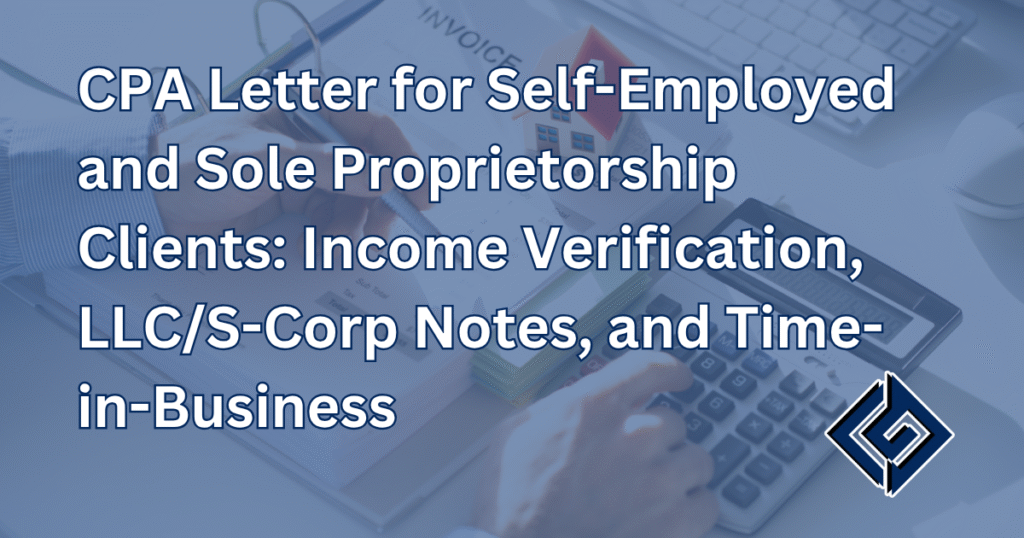Self-employed borrowers face extra questions. A cpa letter for self employed answers them with concise, lender-ready facts.
It shows income, clarifies time-in-business, and explains your LLC or S-Corp setup.
It also helps with rentals. If a leasing office asks, the same data can support a cpa letter for apartment applications.
What This Letter Is—and Why It Works
A licensed Certified Public Accountant (CPA) prepares a short, signed letter.
It confirms what a lender or landlord needs to see.
It ties numbers to records and states limits clearly.
What the letter usually covers
- Identity of the client and business.
- Time-in-business and ownership.
- Income for a defined period.
- Notes on LLC or S-Corp elections if relevant.
- Methods used for verification (returns, statements).
- Scope limits. No forward-looking promises.
What the letter is not
- Not an audit or assurance report.
- Not legal or tax advice beyond the stated scope.
- Not a replacement for lender underwriting.
Standards and Licensure You Can Point To
Your letter is issued by a CPA with active licensure.
Work follows AICPA(American Institute of Certified Public Accountants) ethics and third-party letter boundaries.
Many practitioners reference the Journal of Accountancy and firm policies for consistent language.
Verified signals inside the letter package
- Expertise: CPA name, CPA license jurisdiction, firm contact.
- Experience: background in public accounting, taxation, or small-business accounting.
- Authoritativeness: alignment to AICPA guidance.
- Trust: clear scope, accurate tie-outs, secure delivery.
When Lenders and Landlords Request It
Mortgage and refinance
Underwriters use the letter to place self-employment income.
It connects filed returns and current activity.
Lines of credit and business loans
Credit teams ask for time-in-business and a short stability note.
The letter references the records they rely on.
Rentals and relocations
Leasing offices may accept a cpa letter for apartment along with pay docs or bank history.
Some will ask for notarization. That can be added if required.
Documents You’ll Need
Short list. Clean copies speed the file.
Core financials
- Most recent federal taxation returns (personal and business).
- Year-to-date financial statements (P&L and balance sheet).
- Recent bank activity for deposits.
Entity and election items (if any)
- Articles or operating agreement (for LLC).
- S-Corp election (Form 2553) if applicable.
- Ownership and percentage notes for partners.
LLC and S-Corp Notes the Letter Can Address
Self-employment income is not all the same. Structure matters.
Your letter can add a short paragraph that explains treatment without turning into advice.
Sole proprietorship
- Income reported on Schedule C.
- Draws are not expenses.
- Emphasize deposits and gross receipts tie-outs.
LLC taxed as partnership
- K-1 flows to personal return.
- Clarify ownership percentages and distributions.
S-Corp
- W-2 wages to the owner officer plus pass-through income.
- Note reasonable compensation has been considered in filings.
Keep it practical
- Focus on what changed year over year.
- State the period and records used.
- Avoid legal conclusions.
Time-in-Business: Why It Matters and How We Show It
Lenders want to see stability.
Your CPA can reference licensing dates, first filed return, or formation documents.
Ways to document time-in-business
- State registration or formation date.
- First filed business return date.
- Continuity shown in bank and P&L records.
If the business pivoted
Call out the change briefly.
Explain how revenue lines evolved, using plain language.
How We Verify Income (Without Turning It Into an Audit)
This is verification, not auditing.
Procedures are narrow, defined, and repeatable.
Typical procedures
- Agree P&L revenue to recent deposits.
- Tie annual totals to filed tax returns.
- Recalculate simple margins or an expense percentage if the lender requests it.
Clear limits
- No opinion on future income or solvency.
- No broad testing of controls.
- No assurance beyond what is listed.
CPA Letter for self employed Sample
Subject: CPA Letter for Self-Employed Income — [Client/Business]
I am a CPA for [Client]. For the period [dates], I reviewed filed tax returns, current management financials, and selected bank activity.
Based on these records, income for [period] was $[amount]. Business start date: [MM/YYYY]. Entity: [Sole Proprietorship/LLC/S-Corp].
Procedures were limited to comparisons and tie-outs. This is not an audit or review under AICPA standards.
Signed, [Name], CPA — [Firm], License [State]
If the landlord requires a notarized
Add a notary acknowledgment below the CPA signature to produce a notarized cpa letter.
Where This Helps Most in a Mortgage File
- Clarifies variable revenue and seasonality.
- Bridges Schedule C or K-1 income to current-year results.
- Documents time-in-business without a long memo.
- Reduces follow-up emails from underwriting.
Pricing, Timing, and Delivery
- Pricing: flat fees for standard requests; add-ons for rush, notary, or custom lender wording.
- Timing: short timelines once documents are complete.
- Delivery: PDF on firm letterhead; secure email or direct lender upload.
Common Pitfalls to Avoid
Mixing cash and accrual with no note
If bases differ, include a one-line explanation.
Underwriters look for consistency.
Missing months
Do not leave gaps between bank statements and the YTD P&L.
Provide clean, continuous periods.
Over-promising language
Keep to AICPA boundaries.
Avoid future assurances and broad opinions.
